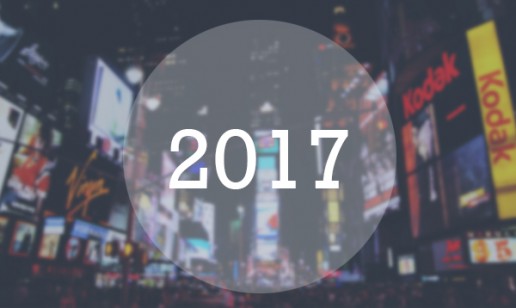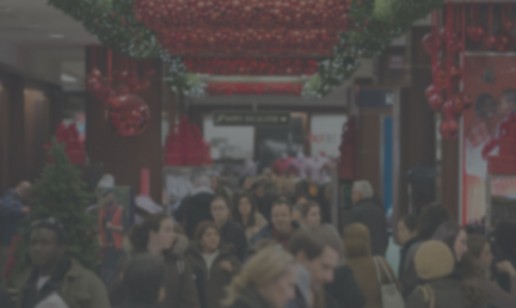The Ultimate ABCs of Programmatic Advertising: A is for?
ATD, CPL, DSP, CPA, SDK…
Is this even English?
*This is part 1 of a series, The Ultimate ABCs of Programmatic.
ATD, CPL, DSP, CPA, SDK…Is this even English?
No, you didn’t just read a string of nonsense.
These acronyms, which I’m sure you’re always hearing Ad Ops throw about, are actually representative of important elements of Programmatic Advertising.
But let’s admit it, they can be incredibly confusing.
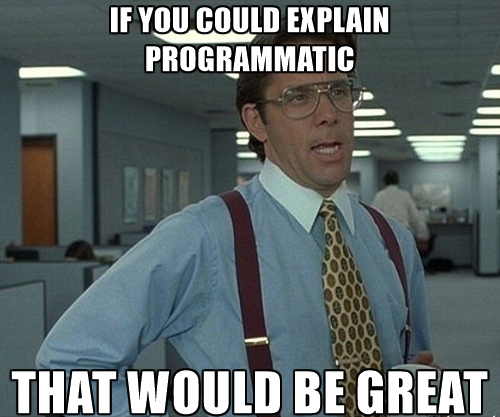
In this series, “The Ultimate ABCs of Programmatic Advertising,” we set out to get you fluent with all the specific programmatic media buying terms and acronyms.
If you’re new to programmatic, this series is for you. Keep reading!
In Programmatic Advertising,
“A” is for…
Ad Server
A technology that offers the means to store and delivers advertisements onto digital platforms including websites, social media, and apps. Ad serving companies also function to count clicks or impressions of ads to help advertisers track their campaigns and return on ad spend (ROAS).
Ad Space
An area of a digital platform, including websites, social media, and apps, that is reserved for displaying online advertisements.
Ad Exchange
Often likened to stock markets, an ad exchange is a virtual marketplace that allows advertisers and publishers to buy and sell ad space usually through real-time auctions. Ad types sold on exchanges can be display, video, and mobile inventory and winning impressions are determined by a set bid price in combination with historical user behaviour, time of day, geographic-location, and device.
Exchanges are beneficial to advertisers because they allow ads to be bought at scale, that is, across a large array of digital platforms at once as opposed to individual, time-consuming direct buys.
Examples: DoubleClick by Google, BrightRoll by Yahoo, Rubicon Project, AppNexus, OpenX etc.
Ad Exchange, Open (Public)
Open ad exchanges, A.K.A public exchanges, are virtual marketplaces that allows advertisers and publishers to buy and sell ad space. Open exchanges are publicly accessible to any advertiser or publisher. Open exchanges have come under fire for a lack of accountability, problems with ad fraud and reliance on third-party data which can limit audience targeting.
Ad Exchange, Closed (Private)
Closed ad exchanges, A.K.A private exchanges, are virtual marketplaces that allow advertisers and publishers to buy and sell ad space. Private exchanges are not publicly accessible to just any advertiser or publisher.
Private exchanges are much more controlled environments where only select advertisers and publishers are invited in to buy and sell. Private exchanges, often run by a large group of publishers, are growing in popularity as they are seen as safer environments with less fraud, as well as first-party data to improve audience targeting.
Ad Network
A company that connects a large number of websites and aggregates ad inventory to sell for a profit. Ad networks originally came about as a way of offering advertisers scale and audience reach. Premium content has historically not been a major concern for ad networks.
Ad networks have been criticized for driving the cost of inventory up as they can and have broker sales between themselves causing the daisy chain problem.
Examples: AdSense, BuySellAds, Conversant etc.
Agency Trading Desk (ATD)
Agency Trading Desks (ATD) are the in-house programmatic ad buying team in advertising agencies. ATDs offers real-time ad and audience buying as a managed service for clients.
Typically the inventory made available through ATDs have been described as remnant publisher inventory – the same inventory sold to ad networks. Complaints about ATDs have arisen around the issue of double paying agencies for both agency services and trading desk services, or conflicts of interest between buyer and seller.
Awareness
The first stage of a full-funnel marketing or purchasing model. Awareness precedes interest, consideration, conversion (and loyalty and advocacy) in the buyer journey and encompasses the moment when potential customers first learn about a product or service.
In the context of programmatic advertising, running awareness campaign is an important prospecting process to help identify potential users or customers. By tracking and measuring ad performance, for example, full video views, early in the buyer process, programmatic media buyers can strategize on how to target these prospects (based on interest) later in the funnel and drive them towards conversion.
If you didn’t know, now you know.
Stay tuned for more in upcoming posts in this series. Next up, we explore and define the Bs and Cs of Programmatic.
Want to learn more? Connect with our team at sales@clearpier.com
Top 10 Marketing Trends of 2017
Demand for Performance to grow as technological innovations and marketing strategy advances in 2017.
https://www.youtube.com/watch?v=X7HLEMcop8U&t=4s
2016 was a big year for marketers around the globe, filled with major shifts across the digital media landscape. AR quickly entered the mainstream with the swift rise (and fall) of Pokémon Go, perhaps one of last year’s biggest pop-culture phenomenons. Everything online was about or delivered in the form of video, and changes in direct-on-social-selling has altered the buyer journey.
With all the changes that occurred, what can we expect as we move swiftly into the new year?
Here are our team’s predictions on the biggest marketing trends of 2017.
1. Influencer Marketing budgets will double

Influencer marketing, continues to be an effective way for advertisers to reach niche audiences.
In 2017, investments by brands into influencer marketing may grow by 48%. As a strong strategy to get in front of audiences through trusted recommendations while simultaneously getting around the problem ad blocking, influencer kills two bird with one stone. You can bet that this is one channel that won’t be slowing down any time soon.
2. More emphasis on Interactive Content Marketing

Move over read-only content, interactive content is about to shake things up.
Marketers know all too well that attention spans are getting shorter, and interactive content may be the answer to cut through the noise to get audiences to engage with branded content at a deeper level.
From quizzes, polls, surveys, and contests to infographics and before-and-after reveals, interactive content seems to be growing in popularity. Many content experts believe it may in fact be a better way to educate readers while simultaneously allowing marketers to collect data.
3. Demand for Performance will Grow alongside demand for brand safety
More brands, agencies, and advertisers will shift their budgets towards Performance in 2017 to better align budgets with ROI.
Companies will look to work more closely with performance partners that have the technology and experience needed to better manage, track and optimize their campaigns rather than trying to build a performance unit in-house which requires a steep learning and development curve for immediate success. Vendors who can guarantee performance, scale, and brand safety will also grow in demand.
4. Social Media continues to be a strong channel for brands, content and SEO strategy

Facebook isn’t going away. Influencer marketing will be heavy on Instagram. And with over 100 million daily active users and 400 million snaps per day, every marketer’s Snapchat game better get on point.
But there will be shifts. Capturing moments and experiences will be a valuable and trendy tactic for brands to reach social media savvy audiences. It’s no longer enough to post about what it was like to be at an event, wear a new shirt, or taste a new recipe – now marketers need to show audiences what it feels like. Real-time posting will be ever more in demand to make experiences immersive and genuine.
5. Virtual/Augmented Reality will further be explored
Virtual and augmented reality is here! Snapchat and Pokémon Go have done wonders to expand the horizon for augmented reality. The question for brands now is how to best utilize the technology.
While some businesses may still be on the fence about AR, e-commerce retailers without brick and mortar stores may find the technology advantageous. As the technology and its accessibility continues to advance, we can be sure to find more marketers jumping onto the AR/VR bandwagon.
6. Video + Live Streaming
Video will continue to dominate in 2017 and we will see the use of live streaming grow.
It’s important to note, however, that video will be driven by mobile which means marketers will need to maintain a mobile first strategy. With over 90% of Facebook feeds filled with video, and mobile video stats ballooning since 2015, we can expect the shift towards video to continue.
Though it’s a time consuming medium, the demand for video among audiences is only growing and marketers need to embrace the change.
7. Native Advertising will grow but face scrutiny

It’s been a somewhat problematic year for native advertising given the discussions around the problem of ‘fake news’ online. We know that native advertising is designed to promote branded content in an organic, uninterrupted way, but 2016 brought to popular attention the need for marketers to run creative native content responsibly.
Disclosure – that is, clear identification of paid native ads around editorial content – will remain the biggest concern for native advertisers this year. The IAB predicts that in-feed native will continue to make up the bulk of native ad revenue, and brands will continue to shift their ad dollars towards native.
8. Mobile First – Always

In the past several years, it has been drilled into our heads that marketers need to be on mobile because that’s where consumers are.
We’ve all wisely shifted to mobile. Indeed, according to venturebeat.com, approximately 59.5% of Google’s net global ad revenue will come from mobile ads this year (up from 45.8% in 2015).
While the shift to mobile has resulted in the growing monetization of apps, as well as increased demand for video, the problem remains: bots follow the money trail. CMO.com predicts that ad fraud bots will behave even more like humans in 2017, making it ever more difficult to detect.
Advertisers will need to be vigilant and persistently press vendors for transparency on how their budgets are being spent, which is why many Canadian advertisers are beginning to shift their attention to private marketplaces.
9. Everything will be personalized

To reach the right audience at the right time, we as marketers need to send the right message and that requires personalization.
In 2017, personalization will continue to be top-of-mind as audiences become more acutely aware and critical of what and how marketers communicate with them. Marketers will need to keep audience lists healthy and well segmented according to behaviour, preferences, habits, geo-location and more to continue winning positive audience attention and engagement.
10. Customer Experience will come first

Understanding the importance of the customer experience is at the core of any strong marketing strategy. Businesses that embrace a customer-centric approach will find more success in the year ahead.
But how do you make the shift? Consider the following:
- Turn customer service into an essential business mantra, across departments
- Listen to your customer’s feedback and make changes that answer their needs
- Re-imagine social media as an extension of customer support
Now you know the biggest marketing trends to watch out for in 2017. So get out there, and start making awesome happen all year long.
Want to learn more? Connect with our team at sales@clearpier.com
Why Publishers Need to Prioritize User Experience in 2017
A new mantra has taken over the publishing world and it goes by the name of “user experience.”
A new year has dawned on us and with it, a new set of priorities. A couple years ago, we were shouting “content is king” at the top of our lungs. But a new mantra is here to dominate the publishing world in 2017, and it goes by the name “user experience.”
It’s all well and good of publishers who are producing amazing, enthralling, and interesting content, trying to earn the loyalty of their readership. But how can your content even reach your audience, if your user experience is driving them to click away?
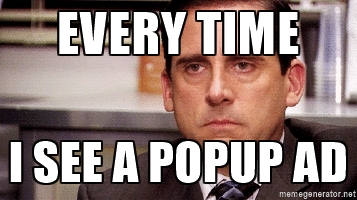
We’ve all been on the other side as readers. You visit a website and suddenly you’re bombarded with way too many ads for products you’re not even close to interested in, all crammed on a page that took forever to load. Then suddenly an intrusive pop up interrupts your reading. You can’t find the navigation bar, there are too many “recommended readings” that seem a little sketchy, and something about the page’s aesthetic is just not pretty.
What do you do next? You click away! Chances are if you’re doing it, your readers are doing it too.
Poor user experience has a number of cumulative problems.
- Slow Load Times
- Increased Bounce Rates
- Reduced Engagement
- Incentivized Ad Blocking
- Poor Viewability
- Weakened Revenue Generation
Each are a result of major challenges all publishers face. If you’re not filling your site and inventory to its maximum, then you’re losing out on opportunities to capitalize. You need maximum fill to happen, but too many complicated ads can slow your load times which drives away potentially loyal readers who.
Too many irrelevant ads prompts banner blindness and therefore reduced engagement. Worse yet, they could be what pushes your audience to turn on the ad blockers and empower their user experience themselves.
With viewability increasingly becoming a major KPI for your ad partners, a lack of placement optimization could mean that you’re running ads in placements that either have the wrong traffic or aren’t even seen.
Beyond these issues, publishers also have an added challenge: not knowing who is running ads on their properties. It’s not just a matter of quality either, it’s an issue of brand safety. Not knowing exactly who may end up running ads on your site could result in inappropriate placements that could hurt your own brand.
So how can publishers take control of their user experience without sacrificing their monetization needs?
1. Change your philosophy

Publishers need to understand that ads are a central part of the user’s experience. Strong UI design that remembers this is what can set a publisher a part and build a loyal following. If you want people to return to your site, you need to make sure their experience is as pleasant as possible.
2. Test regularly

You should be constantly split testing your design and ad placements to understand the impact it has on your audience. Get your readers to actively provide you with regular feedback as well through polls. Trust in your audience, and in the data, to dictate how you redesign to benefit their experience and then watch both viewability and engagement skyrocket as you learn to better optimize ad placements.
3. Forgo bombardment

Respecting your audience’s user experience means listening to their grievances. One of the biggest complaints out there? Too many ads! Reducing your placements doesn’t necessarily mean lower fill rates or less revenue. Users are more likely to return to your site if address the issue of clutter, and fewer ads may allow you to command higher rates and offer your inventory at premium. Most audiences in the digital age are open to some form of advertising, but intrusive ads are often the reason why they click away or turn on the ad blocking.
4. Work with a DMP

The first thought here is why would a publisher need to work with a data manage platform (DMP) anyway? Advertisers require data to target audiences with relevant ads. As publishers, your job is to help facilitate this to protect your audience from irrelevant ads and enhancing their user experience. To do so requires understanding your audience data. Working with a DMP allows you to capture all of your first-party audience data and enrich it with insights for advertisers. The result is more potential to increase your CPMs across direct, performance, and programmatic inventory simply because of accessibility to actionable data insights.
5. Go Private and Premium with PMPs

Fighting ad fraud and ensuring your own brand safety on the open exchange has always one of the top concerns for publishers. But it’s no doubt a challenge without the technical know-how or the right partners. Working with private marketplaces (PMP) can alleviate any concerns publishers have had about offering their inventory for CPMs on the open market. Private marketplaces offer a more transparent and controlled environment where knowing the brands that will be running on your properties is no longer foggy. While complaints have been logged about ad tech having yet to catch up in the PMP ecosystem, some PMPs, not only drive premium Performance but also safeguards publishers from fraud with multiple defense systems.
At the end of the day, publishers must make user experience a priority. Measuring and managing the impact of ads on user experience should be central part of your philosophy to win and keep audience trust. After all, it’s a loyal and happy audience is what drives your revenue generation.
Want to learn more? Connect with our team at sales@clearpier.com
Happy Holidays from ClearPier

As the holiday season approaches, we’d like to take this opportunity to wish you a happy holidays and wonderful new year!
Thank you for your continued support and for following our blog. If you’re not already doing so, remember to follow us on Facebook, Twitter, LinkedIn, or Instagram for instant updates.
Stay tuned for more exciting content on everything digital, performance, and programmatic as we head into 2017.
No matter what you’re celebrating this season, happy holidays!
Cheers,
The Team at ClearPier
Want to learn how ClearPier can help you?
Connect with our team at sales@clearpier.com
5 Creative Tips for Video Ads that Work
Video ad spend continues to grow driven by its ability to engage and strong
click-through rate at 1.84%.
Did you know that by this time next year, US Digital Video ad spend may hit $11.72 Billion? On a dollar basis, US digital video ad spending is expected to reach $28.08 billion by 2020, up from $9.90 billion in 2016 (eMarketer).
Programmatic video buying is also seeing extensive adoption and growth – accounting for 41% of all Digital Video dollars spent. That represents 58% growth over the past 2 years.
The numbers aren’t surprising considering video’s ability to engage and its strong click-through rates at 1.84% (BI Report).
Video is on the up and up as consumers continue to cut ties to traditional media and turn to digital. Audiences are increasingly discovering content, being entertained, and uncovering new brands through video consumption online, most especially on mobile devices.
As demand for video rises, advertisers need to adapt to the new medium to generate maximum results. Earlier this year, Yahoo and Nielsen & Hunter Qualitative partnered to produce a report on native video advertising that also highlighted some best practices for brands to create stronger video ads.
So how can you find success with video advertising? Here are some of the best tips:
1. Use Large Logos
When it comes to video ads on mobile, the larger the logo the better. Large logos can increase brand familiarity by 24%, affinity to convert by 17%, and brand recommendation increase by 33% according to Yahoo.

For Millennial audiences on mobile, affinity conversion increases by 25% when large logos are used – that’s 11.5x higher than on desktop.
So remember to GO BIG with logos.
2. Always Employ a CTA
Consumer purchase intent increases by 14% for video ads on mobile devices if advertisers employ a call to action (CTA).
Encouraging visitors to take a specific action to take them further along your sales funnel. Whether it’s a sign up, call, or click – CTAs represent lower-funnel metrics like purchase intent and brand recommendation which all help measure your ads performance.

3. Optimize Your Creatives for Mobile
When creating your videos keep in mind that on mobile, you can watch video either horizontally or vertically (including vertical landscape and vertical portrait). Optimizing your video ads for screen alignment is therefore extremely important.
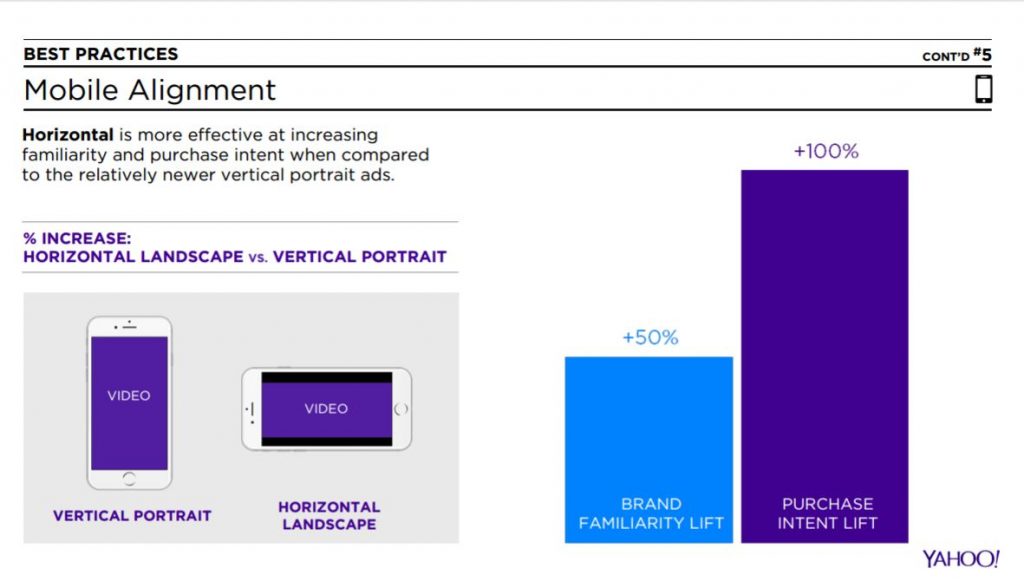 Traditional horizontal landscape videos are the most efficient at driving top and bottom funnel metrics like purchase intent and brand familiarity.
Traditional horizontal landscape videos are the most efficient at driving top and bottom funnel metrics like purchase intent and brand familiarity.
4. Go with Traditional Length for Pre-Roll
We know that the traditional video ad lengths that run for 15-30 seconds work. When videos are shorter, say just 5 seconds, brand affinity conversion, brand recall and purchase intent metrics don’t do so well. 5 seconds may simply not be long enough for audiences to process and recall a brand.
Slightly longer video spots generally perform better, but only if they are entertaining, humorous, interesting, engaging and relevant to the viewer.
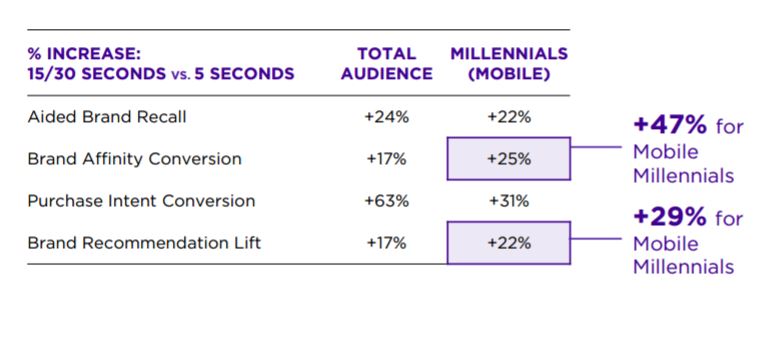
For Native video ads, Yahoo recommends 15 seconds which reportedly drive greater recall and purchase intent.
5. Go Ahead and Auto-Play
Digiday reported earlier this year that 85% of Facebook’s videos are watched without sounds, and other publishers seem to agree.
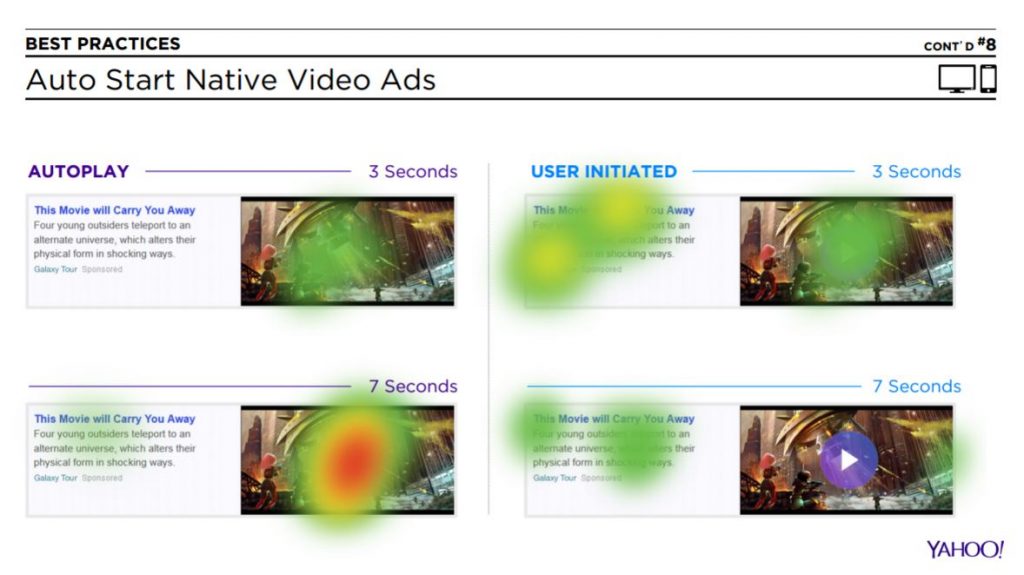
Yahoo advises that auto-pay significantly increases brand recall when compared to user-initiated videos play. Eye tracking indicates that auto-play helps keep viewers focused on the video ad itself, whereas user initiated videos depend more heavily on copy which can negatively impact engagement.
Video ad spend will only grow as the medium matures online and across mobile. But advertisers and brands need to experiment, test and optimize. Just remember to keep these best practices top of mind. Check out the full Yahoo report here.
Learn how ClearPier can improve your video campaigns. Connect with our team at sales@clearpier.com
The Biggest Holiday Shopping Trends of 2016
Mobile a major factor in global
e-commerce sales this holiday season.
Did you know that worldwide retail e-commerce sales will climax at $1.9 trillion by the end of this year?
According to eMarketer, this year’s US holiday retail e-commerce is forecasted to grow 17% hitting $95 billion, and will represent nearly 11% of total holiday retail sales – the largest share of the pie, ever.

So, what are the biggest marketing trends we’re seeing as the holiday e-commerce season ramps up?
1. Sales growth driven by smartphones
Double-digit growth is expected all the way through 2020 when sales will hit $4 trillion. E-commerce is huge, especially during the holiday season and mobile is a driving factor of this growth.
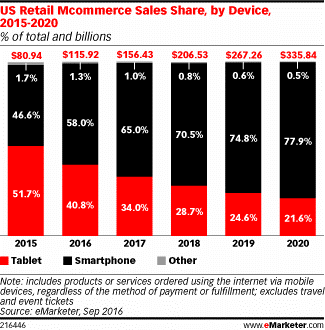
Retailers are in fact embracing mobile and seeking to improve the user’s purchasing experience on mobile.
Improved user experiences, bigger screens, and easy, efficient, and convenient payment methods are likely the main reasons why sales are improving on smartphones.
But more improvement is required to motivate more mobile conversions.
Earlier this year, GfK on behalf of Facebook IQ ran a study of 2400 adults who used mobile phones, tablets, desktops or laptops to research or buy items from online stores over three months. Consumers bought across a range of categories including consumer electronics, clothing, home appliances, home goods, and beauty (AdWeek).
 Although 55% of participants chose to purchase on mobile because of the convenience factor, the study revealed there are significant challenges that still exist for mobile sales.
Although 55% of participants chose to purchase on mobile because of the convenience factor, the study revealed there are significant challenges that still exist for mobile sales.
70% of participating shoppers stated that mobile website and app experiences can still be improved, and that includes a more streamlined final payment process.
Privacy problems, the inconvenience of multi-screen sequential browsing issues, accidental clicks on small screens, and clunky check out processes were all concerns expressed even by mobile friendly consumers.
2. Local mobile search will rise
Multiple consumer touch points are important in the process towards a completed conversion. One of the biggest pros of having a brick and mortar store to service consumers is enabling clients to actually touch and feel a product – a critical, real world touch point.
Interestingly enough, prospective clients are doing so with products in store and on their screens, simultaneously. Mobile in-store searches are up by over 30% according to Google.
Shoppers are increasingly buying on their screens within stores, despite the checkout being so near.

Take me as an example, I’ve been to Ikea a lot this past month (like 5 times and we’re only halfway through the month). Each and every time, I’ve hopped on Ikea’s free WIFI on my iPhone and run some searches before adding items to my online cart.
In fact, Google tells us that 43% of mobile shoppers in consumer electronics have purchased products on their phones while looking at said products in the aisle.
With so much information available at their fingertips for digitally savvy shoppers always looking for deals, you can bet this trend will keep on growing well into 2017. For marketers, this means capitalizing on programmatic geolocation targeting capabilities.
3. Retailers are focusing on unique in-store experiences, supported by strong social media presence
The holidays is one of those times of years when delighting consumers isn’t just part of the spectacle, it’s a necessity.
Over the top window displays, mini-concerts, and special promotions are all part of pushing consumer desire to buy. A couple weeks ago the Hudson’s Bay in downtown Toronto had Mariah Carey perform as they unveiled their always well received holiday windows. The event generated a tonne of hype and free social media buzz produced by the audience in attendance.

Creating memorable experiences is a major retailer responsibility to curate demand, considering consumers know that there is always a deal happening somewhere.
Millennials in particular, drivers of the global economy, generally believe the experience is just as important as the product.
Retailers need to turn to technology to improve the already hectic holiday shopping experience if they hope to boost sales. Self-service technology like in-store kiosks to help with navigation or stock checks (e-catalogs), or express checkout services are all ways that retailers can engage consumers in store and win this holiday season.
Want to learn more? Connect with our team at sales@clearpier.com
18 Simple Ways You Can Segment Your Audience Data in 2017
Marketers must re-examine their audience data and segment creatively. Look beyond just demographics.
We’re midway through November already. The holiday lights are out, the Christmas décor is going up. Soon, we cue the endless music.
Yes, 2016 is coming to a close and as the end draws nearer, it’s high time we start thinking about next year’s revenue goals and ad budget. And to do that, advertisers need to re-examine first, and foremost, their audience data.
Earlier this week we mentioned the importance of audience data in programmatic buying. We argued that ensuring that you have granular audience segments in place to run specific and individual campaigns, rather than broadly scoped ones, will help you find greater success.
While simple demographics like age, gender, and location are great starting points, marketers need to get more specific.
So in the spirit of specificity, here are 18 different ways marketers can segment their audience data to double their ROI in the New Year.
Demographic Segmentation
Demographic segmentation is one of the most common ways advertisers can segment their audiences. These common attributes include the following familiar categories which form the basis of how marketers determine how to market their products.
1. Age
2. Household Income
3. Gender
4. Geolocation
5. Language
6. Education
7. Seasonal
These basic demographics are important to consider because based on, for example, the age groups of your audience, your messaging and even medium may change.
If you’re a cell phone service provider, the creatives you use to reach a millennial audience will be entirely different from your messaging for the baby boomer generation. The packages you sell may differ based on the needs of each age group. On top of this, gender and geolocation will affect the way you design your creatives and where you deliver them.
But wait, there are WAY MORE ways to segment your audience by demographics:
8. Birthday: If you can further segment your audience by birthday, this means you can even run special birthday offers. Sephora, for example, does a great job with this with their Beauty Insider VIB birthday gifts.
9. Weather: Weather based targeting is gathered the same way as geolocation and can influence what products marketers may choose to promote, as well as the messaging that goes along with it.
For example, a fitness clothes retailer may run an ad featuring anti-rain gear in a rainy weather geolocation, and hot weather gear elsewhere.
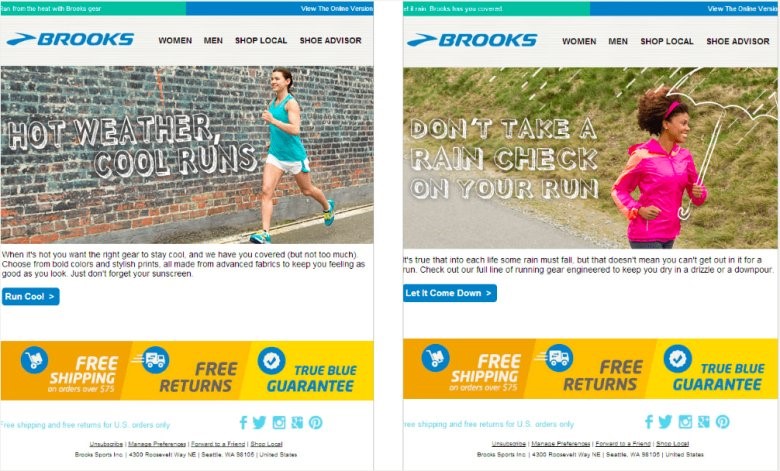
10. Life Stage: You ever change your status to ‘engaged’ on Facebook and then suddenly, you’re bombarded with ads for diamond rings and wedding gowns (yes that happened to me)?
Life stage targeting can be incredibly effective because it’s based on a period in life your audience may be particularly conscious of.
From upcoming nuptials, to entering college for the first time, retirement, or pregnancies, these are major life events and stages that marketers should consider to deliver the right audience to the right audience at the right time.
Behavioral Segmentation
11. Cart Abandonment: For many consumers, price, timing, and shipping are often the culprits behind cart abandonment.
But segmenting out clients who do so – clients who are often on the verge of converting – can help you tailor your retargeting campaign messaging to remind them about what they’re missing out on or if prices change.

12. Type of Shopper: Is your audience a bargain shopper, a luxury shopper, an online-only shopper? Different ‘types’ of shoppers respond to different sales and discounts. The way you sell to a bargain hunter from a luxury shopper vary greatly.
13. Buying History: What does your audience’s historical shopping data look like? Do they buy similar items? Are they always on the hunt for a new tech gadget?
Knowing your audience’s click and purchase history is great for upselling by suggesting similar or complementary products at the final check out.
14. Engagement Level: Highly engaged customers are your best customers because they also act as your brand advocates. Engaged customers spend more on average according to 12ahead, and brands can take advantage of their loyalty by rewarding these clients.
Segment out your highly engaged audience and reward them by allowing them to contribute their ideas to product improvement like Starbucks’ ‘My Starbucks Idea’ or Lay’s Do us a Flavour campaign.

15. Psychographics: It’s like demographics, but more related to your audience’s affinity towards specific values, hobbies, political views, and spending habits. As Hubspot puts it, “demographics explain ‘who’ your buyer is, while psychographics explain ‘why’ they buy.”
It’s important to segment out your psychographic information because you might have two or more completely different sets of psychographics to one set of demographics. Your single male audience aged 25-35 located in Vancouver may all be sports lover, but only half may be inclined to do sports while the other prefer to watch sports.
Social Data Segmentation
16. Brand Affinity: Brand affinity segmentation identifies groups of audiences that have a certain attraction to specific brands and the lifestyles they espouse. For example, Nike and the Just Do It attitude.
You can segment your audience out by specific brands or even by a competitor’s with similar products. If you’re an start up sports gear company attempting to disrupt the market and challenge dominating brands, marketing based on brand affinity can be one way to target your competitor’s audience.
In other cases, brand affinity is an excellent way to inspire cross or co-branded marketing initiatives like this example between BMW and Louis Vuitton.

17. Lifestyle: Your audience segments by lifestyle are ascertained usually by a combination of psychographic, past purchasing data, and behavioural data.
Be it the Savvy Entrepreneur, the Fashion Insider, the Tech Enthusiast, or the Health and Fitness Junkie – lifestyle segments are usually where brands find their brand advocates, influencers, trend setters, and early adopters.
These are the groups of individuals who categorically identify with a certain way of life that is aligned with the brand.
18. Interests: What are your consumer’s favourite television shows, movies, and sports teams? What kind of music do they listen to? What cuisines and restaurants do they love?
These are examples of interests that your audience may identify with which can in many ways dictate the types of promotions you may execute whether online or off.
Now you have 18 more ways to segment your audience data. Now get out there and get creative with your segmentation and double that ROI in 2017.
Want to learn more? Connect with our team at sales@clearpier.com
7 Tips That Will Take Your Programmatic Buying to the Next Level
Knowing your audience at large isn’t enough. You must segment in detail.
Programmatic is all about selling to specific audience segments. Knowing your audience is therefore key to success.
It starts with identifying your audience’s most urgent concerns. Decoding your audience’s main problems will have a profound impact on not just your marketing and messaging, but also on the way you conduct your business overall.
1. Knowing who your audience at large isn’t enough. You must segment in detail.
Audience segments will allow you to clearly define your targeting parameters. Demographics like age, gender and location are great, but they may not be granular enough. For example, say you’re a travel company and you know you have a strong millennial audience. But segment deeper: pockets of your millennial audience may prefer to travel at very specific times of the year and to certain places only. Some may prefer quiet, luxurious retreats, while others prefer extreme outdoor adventures.
Properly segmenting your audiences will allow you to target with more precision and relevancy which are keys to conversion.
2. Understand the Customer Journey

Knowing your audience helps you learn why your audience buys. But getting to know your customer journey helps you determine the how and when they buy.
How do you do this? Make sure that you’re properly tracking your audience’s behaviour and actions as they visit your website. If you work with a DMP, events based data can provide a lot of insight into your audience behaviour.
- Consider the average time spent between first website visit and first conversion. This tells you how long it takes your audience to decide to buy.
- What’s your audience’s pathway towards a conversion? This tells you precisely which pieces of content your audience views before they convert which helps highlight good content from bad.
- Which sales channel results in the highest sales? Knowing your rate of sales per channel helps to identify your best performing channels so you can reallocate your resources to focus on those, or optimize your other channels.
Dissecting all of this will help you optimize your customer’s buying journey and user experience towards more conversion.
3. Set Clear Goals

As with everything in life, setting goals leads to success. The same goes for programmatic buying, so ensure your goals are clear, measurable, and attainable.
Ask yourself and your team, what goals you want to achieve. Do you want to generate more online sales? Or boost brand awareness? Or perhaps you want to influence offline consumer behaviour?
Keep the following KPIs in mind:
- CTR (click-through rates)
- CPA (cost-per-action), CPC (cost-per click) and CPM (cost-per mille)
- Conversions
- App installs
- Viewability
- Reach and frequency
Programmatic buys enable you to measure your audience’s online buying behaviour at nearly every point of the purchasing funnel. Beyond these tangible results, marketers also want to measure brand impact.
While harder to measure, it’s not impossible to correlate. Look to lift in branded searches, social media engagement growth, and attitudes towards your brand as indicators of brand impact even when you’re executing programmatically.
4. Invest in Brand Safety with Premium Inventory

For marketers, there are a number of things that are top of mind when you run a campaign. First, your ad spend budget is finite. You need to make sure that what you spend ensures maximum ROI. Second, your brand reputation is at stake every time you run anything digitally.
So how do you make sure your brand stays safe but you get the most bang for your buck? Invest in your own brand safety and go with premium inventory.
But keep this in mind, not all “premium inventory” are equal. Premium inventory is set within the context of high-quality, brand-safe content – on trusted and reputable properties.
Working with vendors that have exclusive relations with publishers can ensure that your ads only land on these properties. However, for added brand safety look for vendors that provide additional anti-ad fraud security measures. Vendors that work with GeoEdge or Integral Ad Science are concerned with putting your brand safety first.
Demand more from your advertising partners and get a better understanding of how their premium inventory is bought and sold. Ask them which other platforms and exchanges do they work with? The answers will tell you the types of security measures your ad partner has in place to prevent ad fraud and ensure your ad dollars aren’t wasted.
5. Always Employ Data

If you’re running your campaigns without insightful audience data, your ads might as well have never been seen.
The more granular and accurate data you have, the more opportunities you have to improve the accuracy and effectiveness of your campaigns. Data helps determine how well you target, how far reaching your ads are, how many conversions you will achieve, and ultimately, how much revenue you make.
Data can come in the form of 1st party, generally the data you as a marketer collect, 2nd party, non-proprietary data unique data retrieved from a partner, and 3rd party data, aggregated data usually from DMPs that can be built into custom targeting segments.
While each are important on their own, combining your data layers will transform your targeting capabilities and help your campaigns perform better.
6. Use Relevant Creatives
We’ve talked about the significance of relevant creatives before and we’re going to say it again. If your creatives and messaging aren’t relevant, all your audience segmenting and granular targeting parameters are wasted efforts.
If your campaign messaging isn’t relevant to your target audience, it won’t resonate and therefore won’t result in the actions you aimed to stir from your potential customers. Additionally, if you’re always using the same ad copy for your campaigns, you reduce the power of that ad’s ability to persuade.
Split test your creatives, from copy, to images, to the colour of your CTA buttons to optimize for the best results. Refresh your creatives often so you don’t bore your audience.
Consider using Dynamic Creative Optimization platforms (DCO). DCOs can drive better engagement by swapping out components of an ad dynamically, in real time. DCOs can help increase the efficiency of this process, and helps deliver the most relevant creatives depending on your audience’s pass behaviour and targeting parameters.
7. Go Mobile – Now

Everyone has gone mobile. That includes your audience. Are you reallocating enough budget to the mobile market? Optimizing for mobile right now may be one of the best things a marketer can do to boost their campaign results.
In 2015, the Pew Research Center estimated that 64% of American adults own a smartphone of some kind. For many, their mobile devices are their primary way of retrieving information.
In the US, programmatic digital display ad spending will reach $22.10 billion this year – an increase of nearly 40% over last year. A big driver of this growth in programmatic spending is mobile and eMarketer predicts that US mobile programmatic ad spend will reach $15.45 billion by the end of the year to represent 69% of all US programmatic digital display ad spend.
The shift towards mobile has been happening for years and marketers must adapt. Realize that the executions that worked on desktop may not work on mobile. Experimentation on the mobile frontier may be what puts you ahead of the competition.
Want to learn more? Connect with our team at sales@clearpier.com.
4 Ways to Optimize Your Holiday Campaigns for Maximum ROI
From segmenting your data to using a CMP; consider the following.
Put away the pumpkin spice lattes, it’s nearly time to switch over to the egg nog. Every good marketer has at this point fully planned and scheduled their holiday marketing strategies. Campaigns are just about ready to launch. But of course, there is always room for improvements.
Before you launch those campaigns, consider the following 4 ways to optimize your performance campaigns for this holiday season.
- Target creatives according to segmented audience data
If you combine the power of compelling creatives with insightful audience data, you can target your audience more precisely and with relevancy. Consumers are much more inclined to engage with ads that are relevant to their needs. The more interruptive the ad, the more likely they’ll put the blinders on.
Let’s take the Amanda Foundation’s fantastic campaign which is a prime example of how useful segmented audience data can be for targeting.
Each of the advertiser’s creatives uses a shelter animal to promote adoptions. But the messaging is uniquely tailored to the audience based on known browsing behaviour/interests, and demographic data.
So if the viewer is a known foodie who loves trying new restaurants, delivering them creative number three would be perfect to inspire engagement.

- Consider using a Creative Management Platform
Creative management platforms (CMPs) are powerful design tools for the programmatic marketer. CMPs are less technical than Dynamic Creative Optimization tools (DCOs) but also allows designers to make large ad sets as well as small changes to individual creatives. CMPs often have pre-set creative templates that cuts down on design time and makes duplication and customization simple.
It’s a scalable creative production environment where you can create and iterate on only the best performers.
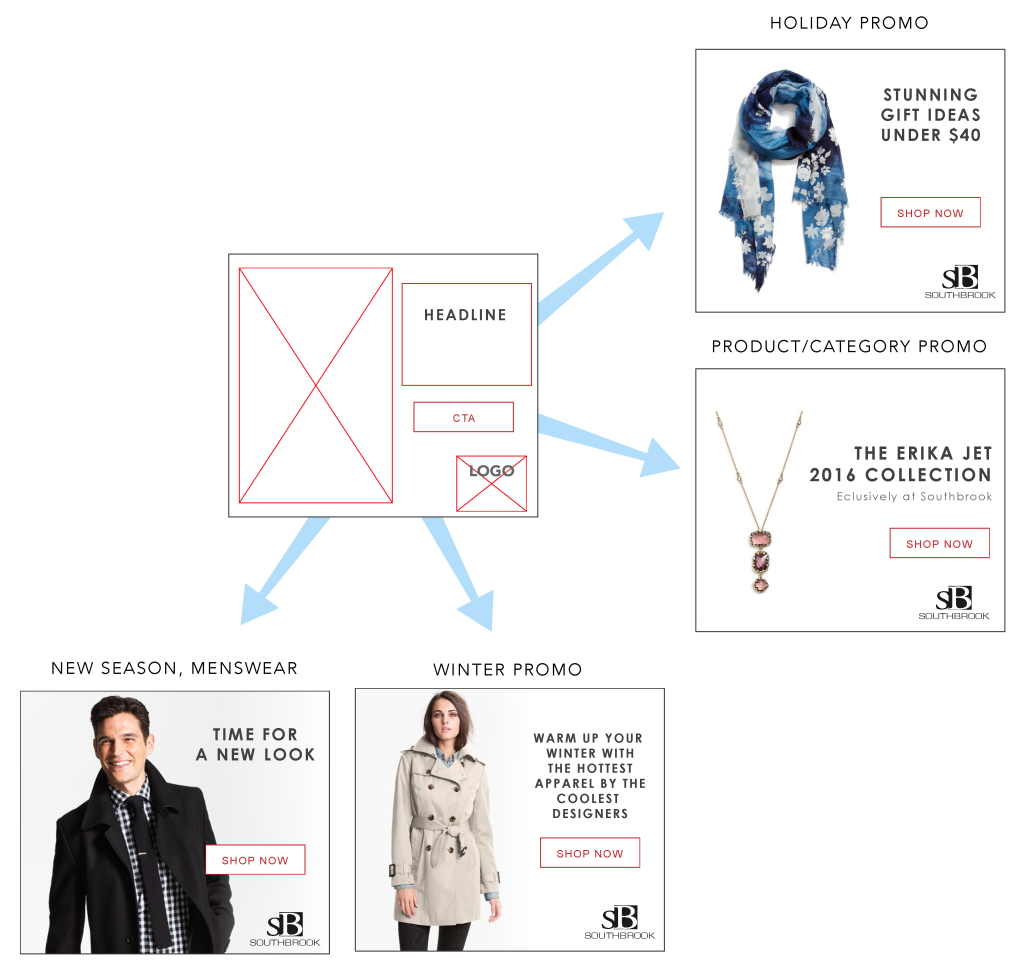
- Remember the importance of “Micro Moments” on mobile
According to Google, 76% of people who conduct a local search on their smartphone visit a business within 24 hours and 28% of those searches results in a purchase. A lot of research is in the pre-sale buyer journey and this will spike as we head into the holiday season.
Google’s series on “I-Want-to-Buy Moments” examined one shopper’s micro-moments (by way of searches, clicks and website visits) over the course of one month to understand how much and how digital research played a role in her purchasing decisions.
The study shows that there are over 1000 digital touch points over a single month leading up to the consumer’s purchase.

Google also shows us the breakdown of her mobile versus desktop search paths:
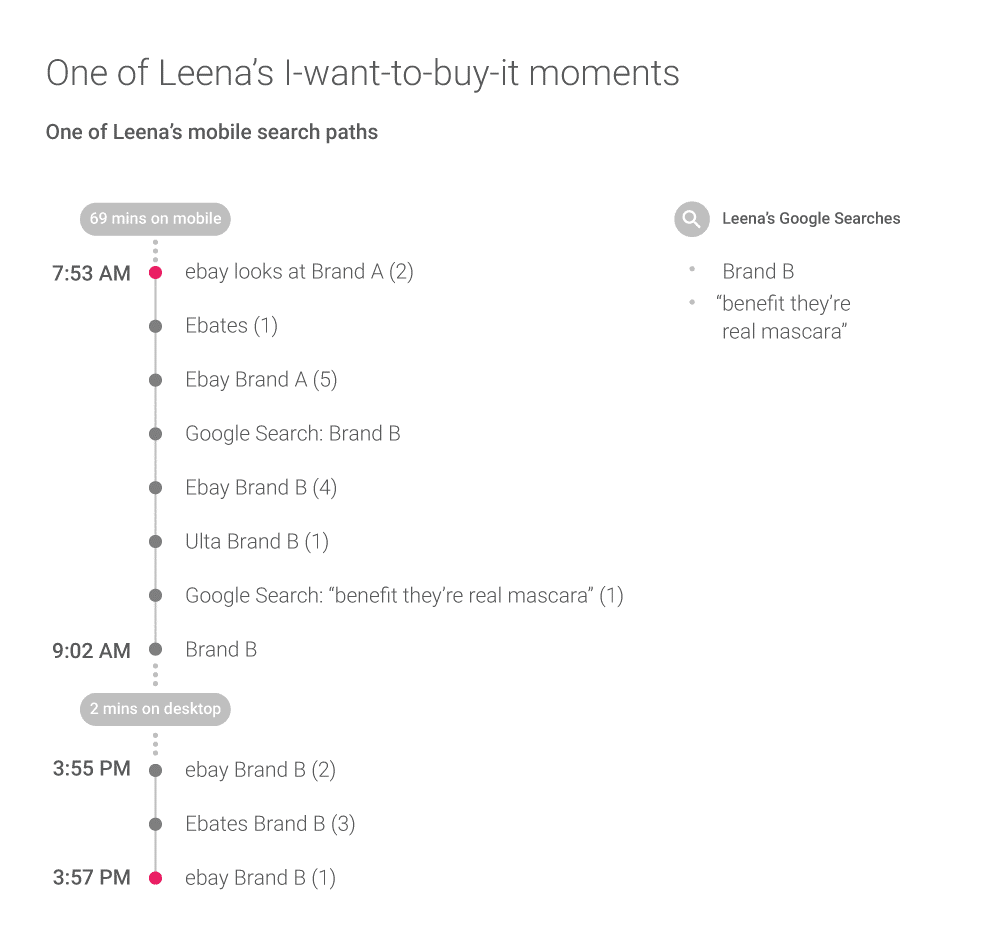 So how can marketers win in these ‘micro-moments’?
So how can marketers win in these ‘micro-moments’?
Be there and be useful. Considering how much research goes into a consumer’s journey now a days, retargeting your ads is a good way to re-engage consumers with buying intent. Remember, although a lot consumers do their research on mobile, buying still happens mainly on desktop. Even upon checkout, marketers can reintroduce promotions, deals, and suggested products for upselling.
- Rotate your ads – or run dynamic creatives
Static banner ads are alright, if they’re well targeted. But banner blindness is indeed a real problem. Keep your visitors curious by rotating fresh creatives in to replace stale ones.
You can up your performance by employing dynamic html5 creatives as well. Why show case only one product, when you can highlight multiple? This is where using a CMP comes in particularly useful as these platforms are often equipped with dynamic creative templates where you simply have to plug in your raw assets.
Best Buy does a really good job at this. Get more out of your ad placement and do more to entice with fresh creatives.

So if you’re not already doing these four things to optimize your campaigns, now is the perfect time to start before the holiday mayhem begins.
Want to learn more? Connect with our team at sales@clearpier.com.
11 Optimization Tools that Will Improve Your Marketing
Looking for tools to help you optimize your marketing stack? Look no further.
What tools do you use to get your online marketing done? Are you a content creationist? Are you a brand marketer? Or perhaps, a social media maven?
Whichever category you fall under, the reality as a marketer is that your stack is often overflowing with tools. But which are the most useful? Which can actually improve your efficiency rather than just adding another layer of work in your daily life?
Look no further! We made you a list of 11 essential optimization tools to help improve all you marketing efforts.
Content Optimization
HubSpot
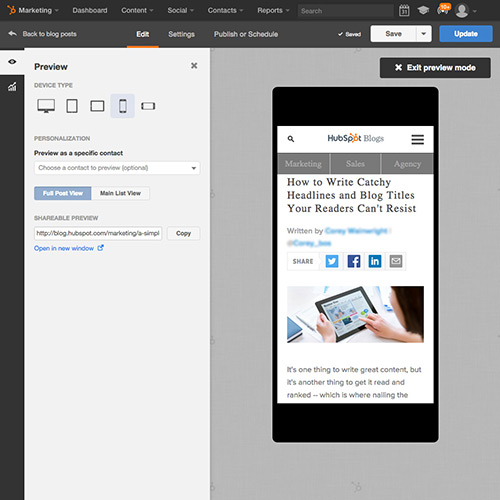
HubSpot is well known for its CRM and especially for its all-in-one inbound marketing software. There are a number of great features that HubSpot offers that’s worthy of highlighting, but let’s focus on their content creation solutions.
HubSpot’s content editor incorporates content layout and copy creation while enabling you to preview how your work will look across devices. This is an incredibly useful tool considering how most readers engage with content on their mobile devices now a days. Adding CTA buttons and building landing pages are seamless in this process as well. But on top of this, SEO optimization is built-into the editor so you can say optimize for keywords while you write and say by to WordPress plugins.
CoSchedule
Similar to HubSpot, CoSchedule offers a great content creation solution for teams. Like HubSpot, you can easily plan and schedule your posts with their content calendar. But CoSchedule has the added feature of being able to schedule your social media posts immediately after you’ve finished writing and scheduling your content.
If you’re like a lot of marketers, you might be using a lot of tools from Google Docs and Analytics, to Evernote and more, so CoSchedule can be a good choice because of all its integration capabilities.
But one of CoSchedule’s best tools is its Headline Analyzer. Just enter your blog headlines and CoSchedule will give you a full analysis with an EMV (Emotional Marketing Value) score out of 100 and a breakdown of the ‘word-type’ components to help you write catchier, more click-worthy headlines. Best of all – it’s a free tool available to everyone.


SEO Optimization
Yoast

If you’re using WordPress to create content, you’re probably familiar with the Yoast plugin. If not, you should be. The basic version enables you to add a focus keyword for your content and provides you with content analysis to improve your readability and SEO.
We all know the importance of building up your blog or website’s SEO so you end up indexed properly across major search engines like Google and Bing. In addition to the XML sitemaps Yoast can generate for you and the keyword optimization, there’s post title and meta-description editors that allow you to fix exactly how your content will be viewed when links are shared socially too.
SEMRush
Equal parts competitive intelligence suite, and SEO optimization solution, SEMRush is a versatile tool in any marketer’s stack.
SEMRush gives insights into your competitor’s strategies across display, organic, and paid search, as well as back links. The company has expanded into display and video analytics recently, but its bread and butter has always been keyword analysis. You simply enter relevant keywords to get an idea of the keywords your competitors are using for their SEO and PPC campaigns, their long-tail keywords, and even their geo-targeting parameters. Leveraging the data on how your competitors are positioning themselves can also help you strategise your next move better.
Moz
Similar to SEMRush, Moz offers great keyword information. But in addition to this Moz helps decipher crawl errors and even provides you with a page optimization score. For publishers and web masters, this is a great tool to run an instant audit of your on-page SEO to optimize for specific and relevant keywords that your competitor is also using. Bonus, its page opportunities identifier helps you uncover what opportunities you’re missing out on your pages to help you improve your search ranking potential.
MonitorBacklinks.com
If you haven’t discovered monitorbacklinks.com, now is the time. Building a strong network of backlinks is important for improving your site’s ranking and boost traffic. Monitorbacklinks.com helps you identify the sites on which the best quality backlinks directing to your site are located.
This helps you identify where the best opportunities lies to build new relations and more content, and ultimately place more backlinks to push traffic towards your business.
Website Performance
Visual Website Optimizer

Visual Website Optimizer (VWO) is a favourite A/B testing software for marketers. Even with no understanding of basic coding, Javascript or HTML, you can tweak and optimize your website and landing pages for better performance. You don’t have to go to your developers and ask for help, VWO really makes it easy to split test multiple versions of your site.
After a simple integration process require you to plug in a small script into your site’s header to verify your domain, you’re ready to start testing. And you can test almost everything from URL split tests, A/B test headlines and images, CTA buttons, or generate heat maps to understand where people are clicking and how to boost your conversions. Bonus, VWO offers a number of analytics and reports so you can identify where the major fixes need to be made.
Optimizely
Like VWO, Optimizely gives you the ability to experiment with your site to optimize towards the best user experience and ultimately conversions. The big difference with Optimizely has to be its mobile optimization tool. If you have an app, this is a great tool to edit your interface on the fly AND run split tests on mobile to ultimately roll out new upgrades in phases, or re-engage your audience.
Social and News Monitoring
BuzzSumo

BuzzSumo is a monitoring tool that helps you keep an eye on your content and understand what performs best based on audience engagement across social. But in addition to this, BuzzSumo allows you to identify the influencers that create and share content relevant to yours.
There’s a “Trending Now” stream that helps you keep a finger on the news pulse running across social. You can filter this according to your own viewing preferences as well. Bonus, there’s a back links tracker and a Facebook analyzer that helps you identify which of your Facebook content is doing best to optimize towards superior social content.
Hootsuite
Hootsuite is one of those essential tools that almost every social media marketer has in their arsenal. We’re all aware that through Hootsuite you can schedule and share social media content across multiple channels. It’s an all-in-one social platform.
But, you can keep an eye on your competitors or industry relevant news by adding their social accounts into your stream. For example, keep an eye on everything eMarketer is posting to their Facebook page by plugging them into your Hootsuite Facebook stream.
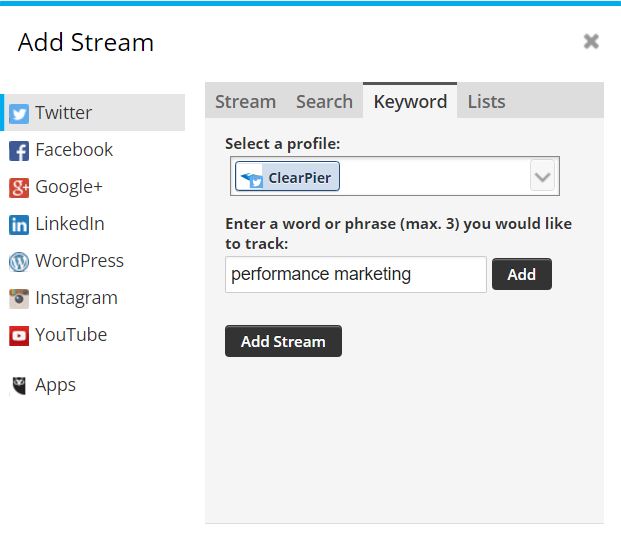 Their Twitter stream is even better: you can add a stream based on keywords. For example, if you add a stream and specify you want to follow keywords like “Performance Marketing” or “Digital Marketing”, these tweets are filtered in and you only see the most relevant tweets in this stream, rather than everything like in your actual news feed.
Their Twitter stream is even better: you can add a stream based on keywords. For example, if you add a stream and specify you want to follow keywords like “Performance Marketing” or “Digital Marketing”, these tweets are filtered in and you only see the most relevant tweets in this stream, rather than everything like in your actual news feed.
Feedly
The best way to start your mornings? With a cup of coffee while scrolling through Feedly, the ultimate news aggregator. Feedly compiles news feeds from a massive number of online news sources all into one news feed that’s personalized to you. Feedly isn’t so much an optimization tool, but using it definitely helps optimize your workflow.
You can sort your news according to subject matter like Business, Design, or Marketing, and get through the most relevant news in the most organized way possible. It’s the easiest way to stay abreast of all of today’s digital marketing news.
And there you have it, 11 essential optimization tools to help improve your marketing that you should be adding to your stack, now. Did we miss anything? What’s in your marketing tool kit?
Want to learn more? Connect with our team at sales@clearpier.com.

